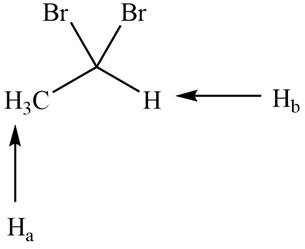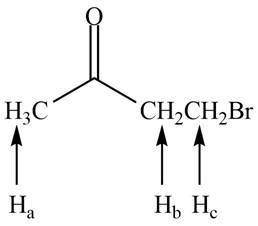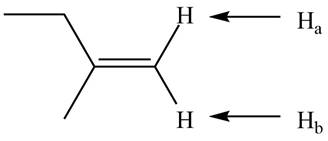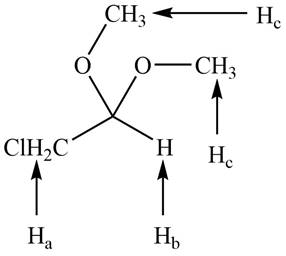
Concept explainers
(a)
Interpretation: The number of peaks for each indicated proton is to be predicted.
Concept introduction: The number of NMR signal in a compound is equal to the number of chemically non-equivalent protons present in that compound. Protons which are present in the same chemical environment that is between the same group of atoms are known as chemically equivalent protons and in
Answer to Problem 14.14P
The given compound shows two signals in
Explanation of Solution
The number of signals in each compound is equal to the number of hydrogen atoms present in a different chemical environment. The given compound is
It has two different types of non-equivalent protons shown in red color. Therefore, it gives two signals in
The given compound shows two signals in
(b)
Interpretation: The number of peaks for each indicated proton is to be predicted.
Concept introduction: The number of NMR signal in a compound is equal to the number of chemically non-equivalent protons present in that compound. Protons which are present in the same chemical environment that is between the same group of atoms are known as chemically equivalent protons and in
Answer to Problem 14.14P
The given compound shows two signals in
Explanation of Solution
The given compound is shown below.

Figure 1
It has two non-equivalent protons. Therefore, it gives two signals in
The signal
The given compound shows two signals in
(c)
Interpretation: The number of peaks for each indicated proton is to be predicted.
Concept introduction: The number of NMR signal in a compound is equal to the number of chemically non-equivalent protons present in that compound. Protons which are present in the same chemical environment that is between the same group of atoms are known as chemically equivalent protons and in
Answer to Problem 14.14P
The given compound shows three signals in
Explanation of Solution
The given compound is shown below.

Figure 2
It has three non-equivalent protons. Therefore, it gives three signals in
The signal
The given compound shows three signals in
(d)
Interpretation: The number of peaks for each indicated proton is to be predicted.
Concept introduction: The number of NMR signal in a compound is equal to the number of chemically non-equivalent protons present in that compound. Protons which are present in the same chemical environment that is between the same group of atoms are known as chemically equivalent protons and in
Answer to Problem 14.14P
The given compound shows two signals in
Explanation of Solution
The given compound is shown below.

Figure 3
It has two non-equivalent protons. Therefore, it gives two signals in
The signal
The given compound shows two signals in
(e)
Interpretation: The number of peaks for each indicated proton is to be predicted.
Concept introduction: The number of NMR signal in a compound is equal to the number of chemically non-equivalent protons present in that compound. Protons which are present in the same chemical environment that is between the same group of atoms are known as chemically equivalent protons and in
Answer to Problem 14.14P
The given compound shows two signals in
Explanation of Solution
The given compound is shown below.

Figure 4
It has two non-equivalent protons. Therefore, it gives two signals in
The signal
The given compound shows two signals in
(f)
Interpretation: The number of peaks for each indicated proton is to be predicted.
Concept introduction: The number of NMR signal in a compound is equal to the number of chemically non-equivalent protons present in that compound. Protons which are present in the same chemical environment that is between the same group of atoms are known as chemically equivalent protons and in
Answer to Problem 14.14P
The indicated protons
Explanation of Solution
The given compound is shown below.

Figure 5
It has three non-equivalent protons. Therefore, it gives three signals in
The signal
Hence, the indicated protons which are shown in red color shows doublet and triplet peaks.
The indicated protons
Want to see more full solutions like this?
Chapter 14 Solutions
Organic Chemistry
- Q5: Label each chiral carbon in the following molecules as R or S. Make sure the stereocenter to which each of your R/S assignments belong is perfectly clear to the grader. (8pts) R OCH 3 CI H S 2pts for each R/S HO R H !!! I OH CI HN CI R Harrow_forwardCalculate the proton and carbon chemical shifts for this structurearrow_forwardA. B. b. Now consider the two bicyclic molecules A. and B. Note that A. is a dianion and B. is a neutral molecule. One of these molecules is a highly reactive compound first characterized in frozen noble gas matrices, that self-reacts rapidly at temperatures above liquid nitrogen temperature. The other compound was isolated at room temperature in the early 1960s, and is a stable ligand used in organometallic chemistry. Which molecule is the more stable molecule, and why?arrow_forward
- A mixture of C7H12O2, C9H9OCl, biphenyl and acetone was put together in a gas chromatography tube. Please decide from the GC resutls which correspond to the peak for C7,C9 and biphenyl and explain the reasoning based on GC results. Eliminate unnecessary peaks from Gas Chromatography results.arrow_forwardIs the molecule chiral, meso, or achiral? CI .CH3 H₂C CIarrow_forwardPLEASE HELP ! URGENT!arrow_forward
- Identify priority of the substituents: CH3arrow_forwardHow many chiral carbons are in the molecule? OH F CI Brarrow_forwardA mixture of three compounds Phen-A, Acet-B and Rin-C was analyzed using TLC with 1:9 ethanol: hexane as the mobile phase. The TLC plate showed three spots of R, 0.1 and 0.2 and 0.3. Which of the three compounds (Phen-A; Acet-B or Rin-C) would have the highest (Blank 1), middle (Blank 2) and lowest (Blank 3) spot respectively? 0 CH: 0 CH, 0 H.C OH H.CN OH Acet-B Rin-C phen-A A A <arrow_forward
 Organic Chemistry: A Guided InquiryChemistryISBN:9780618974122Author:Andrei StraumanisPublisher:Cengage Learning
Organic Chemistry: A Guided InquiryChemistryISBN:9780618974122Author:Andrei StraumanisPublisher:Cengage Learning Physical ChemistryChemistryISBN:9781133958437Author:Ball, David W. (david Warren), BAER, TomasPublisher:Wadsworth Cengage Learning,
Physical ChemistryChemistryISBN:9781133958437Author:Ball, David W. (david Warren), BAER, TomasPublisher:Wadsworth Cengage Learning,


